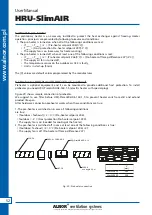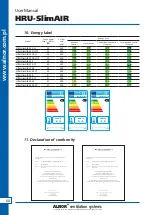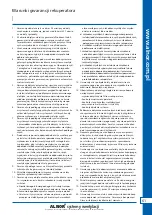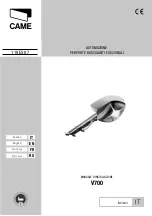
!
51
ALNOR
®
ventilation systems
is a legally protected trademark and technical patent. All rights reserved.
w
w
w
.al
nor
.com.
pl
User Manual
HRU-SlimAIR
6.2 Temperature measurement
The temperature sensors measurement capabilities are from -20˚C to 60˚C.
Supply sensor
The supply sensor measures the air temperature which is blown into the building after it has passed the heat exchanger.
Extract sensor
The extract sensor measures the temperature of air which is extracted from the building before it enters the
heat exchanger or bypass valve.
Internal relative humidity sensor (exhaust)
The sensor is used to measure the total relative humidity from the exhaust rooms. When this value increases
within a short time interval by 5% (adjustable within the range 0-25%), the purging system is activated, i.e. the
speed increases to HOME. In such a case, the unit operates at an increased speed until the relative humidity is
reduced by at least 5% in relation to the starting moment or the humidity is reduced by 5% in relation to the
highest value measured during purging. When the conditions are adjusted to the initial condition, the unit
will remain in purging mode for 15 minutes. If the average value of the measurements performed has not
decreased by 5% when compared to the measurement before the speed increased, the unit will still operate
at the HOME speed until next measurement. This cycle may last up to 1.5 hours.
Exhaust sensor (exhaust)
The exhaust sensor measures of air exhausted from the building after passing trought the heat exchanger.
Ambient temperature sensor (intake)
The ambient temperature sensor measures the temperature of the air taken from the outside before entering the heat
exchanger.
6.3 Frost protection
Frost protection is achieved by reducing the supply fan’s revolutions to the minimum level of the fan. The
whole process goes gradually, depending on the outdoor temperature drop. When the outdoor temperature
continues to decrease and the fan has reached the set minimum revolutions, the extract fan will start to
gradually increase its revolutions. The advantages of this method are a lower airflow unbalance in the system
and the possibility for the unit to work with the pre-heater during the defrosting phase.
The algorithm works when:
The outdoor temperature < (Defrosting set point for frost protection #40[-20]) + (Offset for frost protection
defrost #114[22]) where #40 should be as low as possible as it is responsible for the frost temperature.
The advantage of this method is lower imbalance of the flow system and the possibility of cooperation with
the pre-heater during defrosting operation.
The [X] values are standard values programmed by the manufacturer.
NOTE:
After a power on, the frost protection mode is blocked for 5 minutes.














































